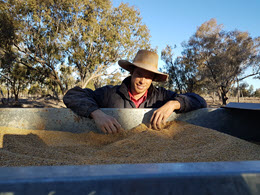Four-part video series targets goat nutrition
24 May 2018

A four-part series of videos focusing on goat nutrition has been released by Meat & Livestock Australia (MLA) to help goatmeat producers plan their annual feeding programs.
The videos have been produced by MLA in consultation with the Goat Industry Council of Australia (GICA) as part of a new series of best practice videos designed to answer commonly asked questions from current and potential goatmeat producers.
The nutrition videos feature interviews with established commercial goatmeat producers as well as experts in the field including land management specialist, Col Paton from EcoRich Grazing and ruminant nutritionist, Matt Callaghan from Ridley.
Parts one and two focus on determining forage supply and forage demand, while parts three and four cover calculating a forage budget and supplementation of goats, respectively.
MLA Project Manager – Goat Industry, Julie Petty, said knowing what type of goat they are aiming to turn-off will help guide producers’ feeding decisions.
“Goats are versatile feeders and will change their feeding behaviour according to forage availability,” Ms Petty said.
“Nutrition is vital to setting and achieving live weight targets, expected growth rates and condition score targets.
“Other profit drivers that can be influenced by nutrition include fertility, maintenance of pregnancy, birthweight and kid survival.”
Two other new goat videos have also been recently released by MLA examining goat genetics and using live weight scales.
“Selection and breeding influences the genetic make-up of a goat herd, which, when done properly, drives the profitability in a goat enterprise and can also influence the markets which may be available to producers,” Ms Petty said.
“The video focusing on live weight scales explains why using this tool is vital to ensuring returns to producers. Producers don’t get paid for underweight goats, so it’s important that producers know the weights of their goats before they’re turned off.
“Monitoring live weights also helps producers to target genetic improvement in their herds.”


